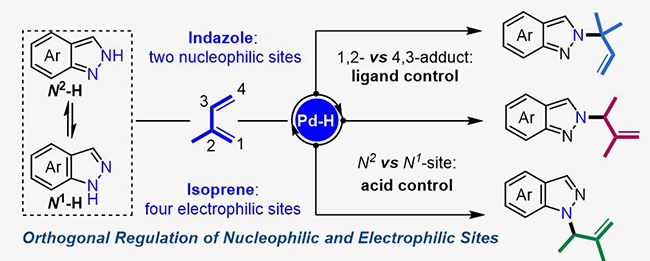Dimethylallyl-related units play a significant role in enhancing lipophilicity of molecules and facilitating permeation across the cellular membrane.
Isoprene can serve as a precursor in the chemical synthesis of dimethylallyl-derived molecules. And indazoles are pharmacologically important scaffolds that found in numerous natural products and drugs.
Recently, a team led by Prof. CHEN Qing'an from the Dalian Institute of Chemical Physics (DICP) of the Chinese Academy of Sciences (CAS), in cooperation with Associate Professor JIANG Xuliang from Shenyang Pharmaceutical University, proposed a strategy that could realize orthogonal regulation of nucleophilic and electrophilic sites in Pd-catalyzed regiodivergent couplings between indazoles and isoprene.
Their findings were published in Angew. Chem. Int. Ed. on Jan. 18.

Pd-catalytic regiodivergent dimethylallylation of indazole with isoprene (Image by JIANG Wenshuang and JI Dingwei)
The researchers found that the 1,2-or 4,3-insertion pathway with respect to the electrophilic sites on isoprene could be controlled by the choice of ligands under Pd-hydride catalysis.
In terms of the nucleophilic sites on indazoles, the reaction occurred at either the N1-or N2-position of indazoles was governed by the acid co-catalysts.
This study not only contributes a practical tool for selective functionalization of isoprene, but also provides a guide to manipulate the regioselectivity for the N-functionalization of indazoles.
"This orthogonal regulation strategy of nucleophilic and electrophilic sites offers new opportunities for the buildup of molecular complexity," said Prof. CHEN.
This research was supported by the National Natural Science Foundation of China and Liaoning Revitalization Talents Program. (Text by JIANG Wenshuang and JI Dingwei)